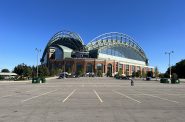Meeting Will Discuss Lake Park Bridge
Historic pedestrian bridge is deteriorating, meeting will discuss options.
Milwaukee County administrators and consultants from the GRAEF engineering firm, will hold a meeting on Thursday, May 5 about planning for the historic Concrete Arch Bridge in Lake Park. It will be held from 5 to 7 p.m. in the Marcia Coles Room, located on the lower level of the Lake Park Pavilion, and will include representatives of Lake Park Friends and other friend groups.
As Michael Horne has previously reported for Urban Milwaukee, county engineers have found “large areas of delaminations on the underside of the bridge,” meaning chunks of concrete could fall to the road and pedestrian walkway some 50 feet below. Ravine Road, located between Lincoln Memorial Drive and Lake Drive, has been closed since November 2014 following concerns about falling concrete from the bridge’s underside.
Beyond that, the bridge has a list of problems noted in his story.
The county board has allocated $400,000 to study options for repairing or replacing the 1905 pedestrian bridge designed by renowned Milwaukee architect Alfred C. Clas. The various options included everything from removing the bridge (at a cost of $120,000) to complete bridge replacement ($2.6 million), Horne reported. In January the county administration sought requests for proposals to design three new replacement bridge designs. In February, GRAEF was awarded a $170,000 contract for phase one of this effort. GRAEF was commissioned to design three alternatives to replace the architecturally significant Concrete Arch Bridge, including an exact replica as well as two other designs inspired by 19th century bridges in parks created by Frederick Law Olmsted.
Considered the father of American parks and the landscape architecture profession, Olmsted designed Lake Park in 1893 while he was also working on the World’s Columbian Exhibition in Chicago. The Olmsted firm continued overseeing the park’s design as other structures were added. Lake Park, including its five historic bridges and other structures, is the only Milwaukee County park listed on the National Register of Historic Places. It is also listed on the state’s historic register and within a City of Milwaukee historic district.
In 2015 GRAEF released a report on the bridge for planning purposes including several options. A public information meeting was held in October to present the study’s findings.
No bids have been sought yet for restoration of the historic bridge.
Correction: The story originally called this a “public information meeting.” But according to Karl Stave, of Milwaukee County’s Architecture, Engineering & Environmental Services, DAS – Facilities Management Division, this Thursday’s meeting is a “work group meeting in preparation for the public information meeting,” which is expected to be held in mid-May. While the public is not barred from this Thursday’s meeting, the later meeting aimed at the public will probably be of more interest to citizens.
More about the Ravine Road Bridge Project
- City Should Enforce Reopening of Ravine Road, Park Friends Say in Filing - Lake Park Friends - Sep 28th, 2023
- MKE County: Ravine Road Debate Heats Up - Graham Kilmer - Aug 14th, 2023
- MKE County: Ravine Road Project Could Begin in 2024, With Pedestrian-Only Option - Graham Kilmer - Aug 1st, 2023
- MKE County: Lake Park Bridge Open For First Time In 6 Years - Graham Kilmer - Oct 29th, 2022
- Friday Photos: Lake Park Bridge Overhaul Nears Completion - Jeramey Jannene - Sep 23rd, 2022
- MKE County: Lake Park Bridge Needs $1 Million More - Graham Kilmer - May 18th, 2021
- County Receives $2 Million Grant for Lake Park Bridge - County Executive Chris Abele - Sep 12th, 2018
- County Parks To Seek State Grant to Fund Ravine Road Bridge Project - Milwaukee County Parks - Feb 8th, 2018
- Op-Ed: Lake Park’s Bridge Spans History - Paul Daniel Marriott - Apr 5th, 2017
- Public Forum For Lake Park Bridge - Virginia Small - Feb 13th, 2017
Read more about Ravine Road Bridge Project here
Back in the News
-
Justice Ziegler Misquotes US Supreme Court Decision
 Dec 2nd, 2025 by Bruce Murphy
Dec 2nd, 2025 by Bruce Murphy
-
Will West Milwaukee Do Development Near Brewers Stadium?
 Dec 1st, 2025 by Bruce Murphy
Dec 1st, 2025 by Bruce Murphy
-
Key Streetcar Opponent Opposes Effort to Shut It Down
 Nov 10th, 2025 by Bruce Murphy
Nov 10th, 2025 by Bruce Murphy




















Please fix the bridge or tear it down. This road is our access point to Lake Michigan.
“Chunks of concrete could fall to the road and pedestrian walkway some 50 feet below”. Closing the road indefinitely is not a solution.
Keep the road closed, take lincoln memorial if you want to get to the lakefront. Parkways are inherently anti-park
It’s still open to walk or bicycle & is the best way to get down the bluff without so much traffic. Seriously, it takes 2 extra minutes to take Lincoln Memorial to the lake, keep it closed to autos!
There are strong opinions on both sides about whether Ravine Road should reopen to vehicular traffic, regardless of what is done with the footbridge.
Olmsted liked to accommodate different types of movement through parks, often separating pedestrians and vehicles as in Central Park. “Parkways” were invented by Olmsted and Calvert Vaux as a design concept both within parks and to connect them and extend the park experience.
Possibly the most major influence Olmsted had on Milwaukee’s overall parks system is the prevalance of parkways linking parks. Olmsted designed Newberry Boulevard to dramatically connect Lake Park and what’s now called Riverside Park. Riverside’s original entrance from Newberry is gone but there was once a continuous flow between the parks.
Thank you Virginia for not hiding behind a generic first name.
Access to the Lake Front is important. The more points of access, the better. This was the intention of the park designer. There isn’t a reason to close this access point.
I didn’t realize the road was still open to pedestrians and bicyclists. Why is the risk of debris falling on a car more concerning than the risk of debris falling on a pedestrian or bicyclist? Whoever closed the road to cars but not pedestrians or bicycles must not have thought this through.
David, I don’t think the roadway is specifically open to bicyclists or pedestrians. There is a stairway that descends into the ravine and links to trails along the road.
I’ve only heard informal discussion about the future access of the roadway and comments following articles on the subject.